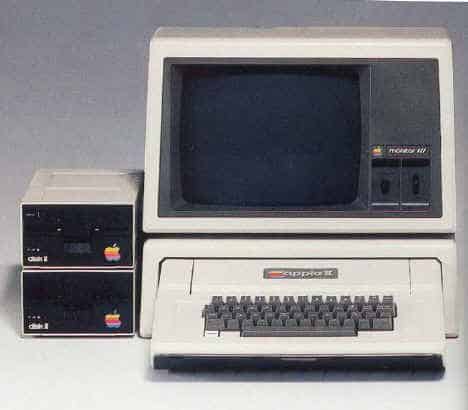
Apple II |
|
CPU |
| CPU: MOS Technology 6502 |
| CPU Speed: 1 MHz |
| FPU: none |
| Bus Speed: 1 MHz |
| Data Path: 8 bit |
| ROM: 12 kB |
| RAM slots: 1st expansion slot can be used |
| Expansion Slots: 8 proprietary |
| Video |
| Max Resolution: 6 color at 280×192, 4-bit color at 40×48 |
| Storage |
| Floppy Drive: optional |
| Input / Output |
| Serial: optional expansion card |
| Speaker: mono |
| Miscellaneous |
| Floppy Drive: optional |
| Codename: ? |
| Introduced: 1977 |
| Terminated: 1980 |
The Apple II (often written as Apple ][ or Apple //) was the first mass produced microcomputer product, manufactured by Apple Computer (now Apple Inc.). It was among the first home computers on the market, and became one of the most recognizable and successful. In terms of ease of use, features and expandability the Apple II was a major technological advancement over its predecessor, the Apple I, a limited production bare circuit board computer for electronics hobbyists which pioneered many features that made the Apple II a commercial success. Introduced at the West Coast Computer Faire in 1977, the Apple II was among the first successful personal computers and responsible for launching the Apple company into a successful business. Throughout the years a number of different models were introduced and sold, with the most popular model manufactured having relatively minor changes even into the 1990s. By the end of its production in 1993, somewhere between five and six million Apple II series computers (including approximately 1.25 million Apple IIGS models) had been produced.
Throughout the 1980s and much of the 1990s, the Apple II was the de facto standard computer in American education; some of them are still operational in classrooms today. The Apple II was popular with business users as well as with families and schools, particularly after the release of the popular spreadsheet, VisiCalc, which initially ran only on the Apple II.
The original Apple II operating system was only the built-in BASIC interpreter contained in ROM. Apple DOS was added to support the diskette drive; the last version was “Apple DOS 3.3”. Apple DOS was superseded by ProDOS to support a hierarchical filesystem and larger storage devices. With an optional Z80 based expansion card the Apple II could even run the popular Wordstar and dBase software under the CP/M operating system. At the height of its evolution, towards the late 1980s, the platform had the graphical look of a hybrid of the Apple II and Macintosh with the introduction of the Apple IIGS. By 1992, the platform featured 16-bit processing capabilities, a mouse driven Graphical User Interface and graphic and sound capabilities far beyond the original.
After years of focus on Apple’s Macintosh product line, it finally eclipsed the Apple II series in the early 1990s. Even after the introduction of the Macintosh, the Apple II had remained Apple’s primary revenue source for years: the Apple II and its associated community of third-party developers and retailers were once a billion-dollar-a-year industry. The Apple IIGS model was sold through to the end of 1992. The Apple IIe model was removed from the product line on October 15, 1993, ending an era.
Source:
Apple II series. (2008, October 11). In Wikipedia, The Free Encyclopedia. Retrieved 11:54, October 12, 2008, from http://en.wikipedia.org/w/index.php?title=Apple_II_series&oldid=244519623
This article is published under the GNU General Public License


[…] 1977 – The first personal computer, the Apple II, goes on sale, retailing for about $1,300.. […]
thank you for the information I needed this for an assignment for my history class I am studying the history of computers so thank you